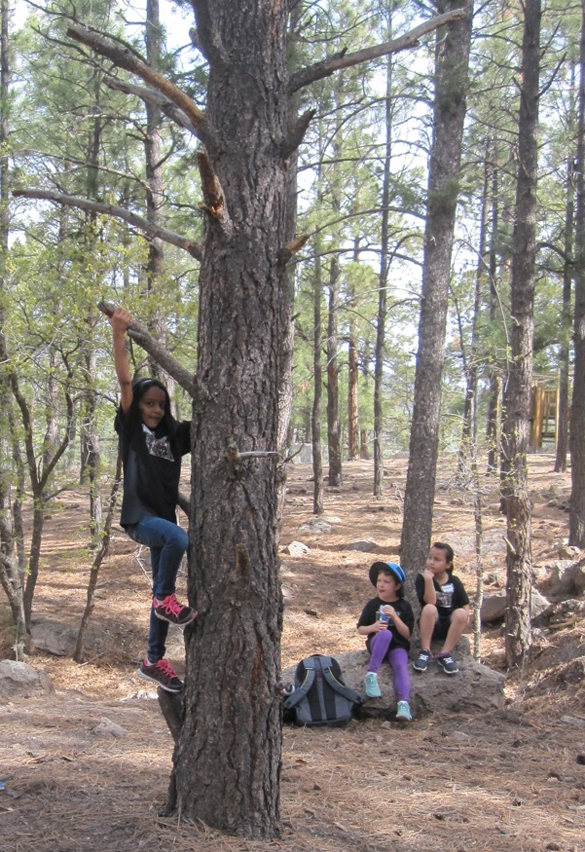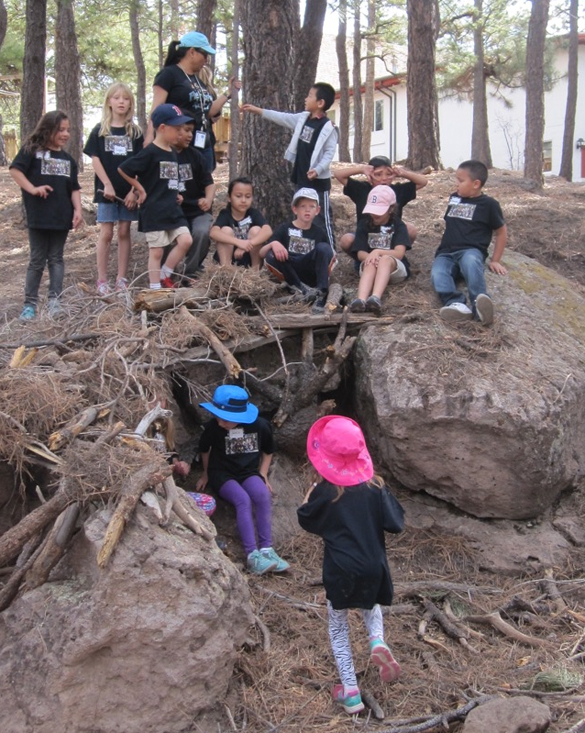 This is the perfect tree for climbing and taking turns going up. Mothers can climb it as well. Photo by Robert Dryja
This is the perfect tree for climbing and taking turns going up. Mothers can climb it as well. Photo by Robert Dryja
 PEEC Amateur Naturalist
PEEC Amateur NaturalistBy ROBERT DRYJA
The Human Ecology of Ponderosa Trees
We tend to think of the ecology of the natural world as separate from what people do or the way they live. This difference quickly disappears when children and parents together explore the forests around Los Alamos. A good observation point is between the new Nature Center and the Jewish Center, where an arroyo divides a small forest of ponderosa trees into two sections.
Remarkable things happen when people encounter a particular ponderosa tree in this forest. This tree is one of many and initially it does not look very different from the other trees. However, a six-year-old child quickly sees something special. Before they died, its lower branches were about four inches in diameter. These branches now have broken off, leaving stubs that project out short distances. These stubs are ideally spaced for climbing. This tree has quickly become known as the “climbing tree.” Additionally, the dead branches from this tree and the other trees around it are ideal for making stick forts in the arroyo.
Groups of children and adults on recent field trips to the Nature Center encountered this tree and the branches lying around it.
One group included a boy who was totally blind. An assistant helped him to hike into the arroyo where the other children were making a stick fort. The boy and his assistant spent their time lifting and piling stones of different sizes. The boy appeared to be using his sense of touch, motion, and weight to understand the rocks. He also was listening to children near him. I suspect he was learning about the world in a way that could not easily occur in a classroom. He was now part of the ecological landscape of the trees.
Another group had a boy in a wheel chair who appeared to be totally paralyzed from the waist down.
His assistant brought him to the “climbing tree.” He proceeded to pull himself up the branch stubs, arm over arm, from branch to branch with his legs dangling. He was discovering something about his abilities and that he could be like the other children. The growth of the tree led to his growth as well.
A girl also was interested in going up the climbing tree but was not confident. Her mother eagerly climbed up the tree and called her daughter to come join her. The girl promptly climbed up to join her mother. I now know that the branches of a ponderosa tree can be used for a bit of parent-child bonding and encouragement, as well as supporting pine needles for photosynthesis.
The tree branches on the ground provided practice in cooperative learning and engineering design. Groups of children figured out how to carry branches to the arroyo to make a tree fort. Much thought and discussion went into where and how to place the branches. The children interacted to make a fort, much as the trees interacted for their mutual and optimal growth.
 Moving a 25-foot branch requires teamwork. Photo by Robert Dryja
Moving a 25-foot branch requires teamwork. Photo by Robert Dryja Bring big branches first for the bottom. Sticks next. Finally pine needles on top. And we figured this out ourselves. Photo by Robert Dryja
Bring big branches first for the bottom. Sticks next. Finally pine needles on top. And we figured this out ourselves. Photo by Robert Dryja

